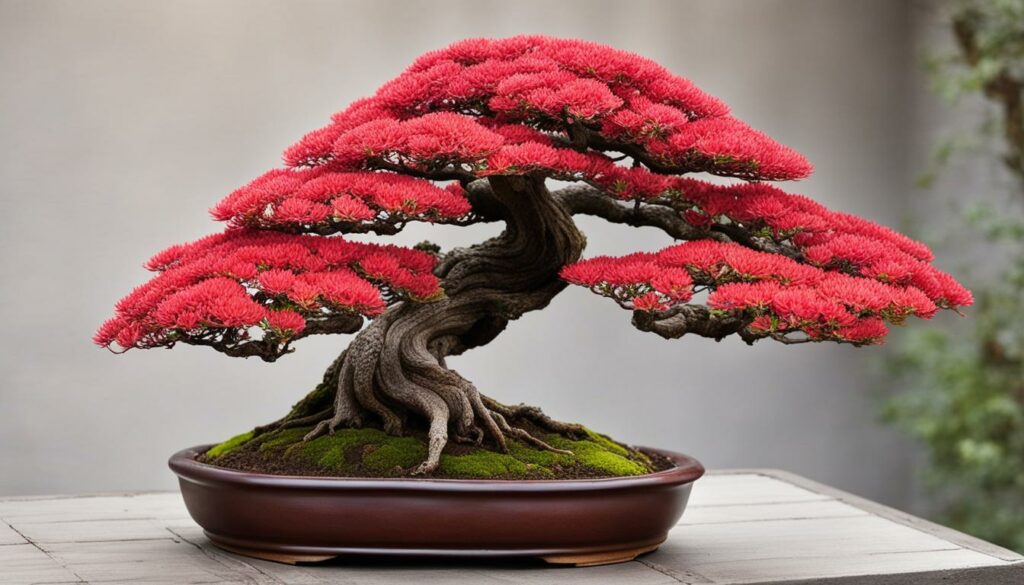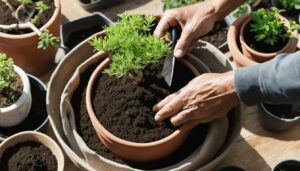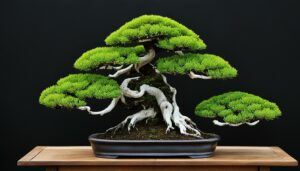If you’re new to bonsai cultivation, it’s essential to understand the progression and development stages that your tree will go through. Nurturing your bonsai to its full potential requires knowledge and patience. The art of bonsai is a journey in which you will learn to appreciate the beauty of the evolution of your tree over time. In this section, we’ll explore the vital stages and techniques that are necessary to ensure the healthy growth of your bonsai tree.
Key Takeaways:
- Bonsai cultivation progression and development require time, patience, and knowledge.
- Understanding the distinct stages of bonsai development helps you nurture your tree to its full potential.
- The beauty of bonsai lies in the appreciation of its evolution over time.
- Proper care techniques, such as soil selection, pruning, and watering, are essential in bonsai cultivation.
- The art of bonsai is a long-term commitment that requires succession planning and passing on the bonsai legacy to future generations.
The Importance of Bonsai Growth
Bonsai growth is a transformative journey that your tree goes through. It is a fulfilling experience to watch your plant evolve over time. Understanding the stages of its evolution is key to appreciating its development.
Bonsai cultivation is an art that requires patience and attention to detail. As your tree progresses, you will notice significant changes in its appearance and structure. From its initial planting to the final form, you will witness its incredible growth and development.
Bonsai Evolution
As your bonsai tree grows, it will evolve through various stages. The first stage is known as the establishment stage, where your tree acclimates to its new environment and establishes its roots. The next stage is the development stage, where your tree will grow rapidly, and you will see significant changes in its structure and appearance. Finally, the maturity stage is the last stage where your tree reaches its final form.
Each stage is unique and requires different care techniques. Understanding the stage that your bonsai is in is essential to its development. Remember to monitor its growth progress to make sure it stays healthy and vibrant.
| Stage | Description |
|---|---|
| Establishment | Acclimation and root development stage |
| Development | Rapid growth and structural changes stage |
| Maturity | Final form and aging stage |
The journey of bonsai cultivation is a fulfilling experience, and understanding the importance of bonsai growth and the transformative journey it goes through is critical to successful bonsai care.
Starting with the Right Bonsai Species
When it comes to bonsai cultivation, selecting the right species is crucial to ensure its optimal growth and development. Different species have different needs and care requirements, so it’s essential to choose the one that is most suitable for your environment and lifestyle.
The first step in selecting a bonsai species is to consider the climate and weather conditions of where you live. Some species thrive in hot and humid climates, while others do best in cooler environments. You also need to consider factors such as the amount of sunlight available and the soil composition in your area.
| Bonsai Species | Best Environment |
|---|---|
| Juniper | Outdoor, lots of sun |
| Japanese Maple | Outdoor, partial shade |
| Ficus | Indoor, bright light |
| Chinese Elm | Outdoor, full sun to partial shade |
Once you’ve determined the best environment for your bonsai, you can then select a species that requires similar care. When selecting a species, consider the tree’s growth rate, size, and shape, as these factors can affect the styling and growth of your bonsai. It’s also essential to choose a species that is readily available and affordable in your area.
Overall, taking the time to research and select the right bonsai species for your cultivation journey will pay off in the long run, as it will ensure that your bonsai thrives and reaches its full potential.
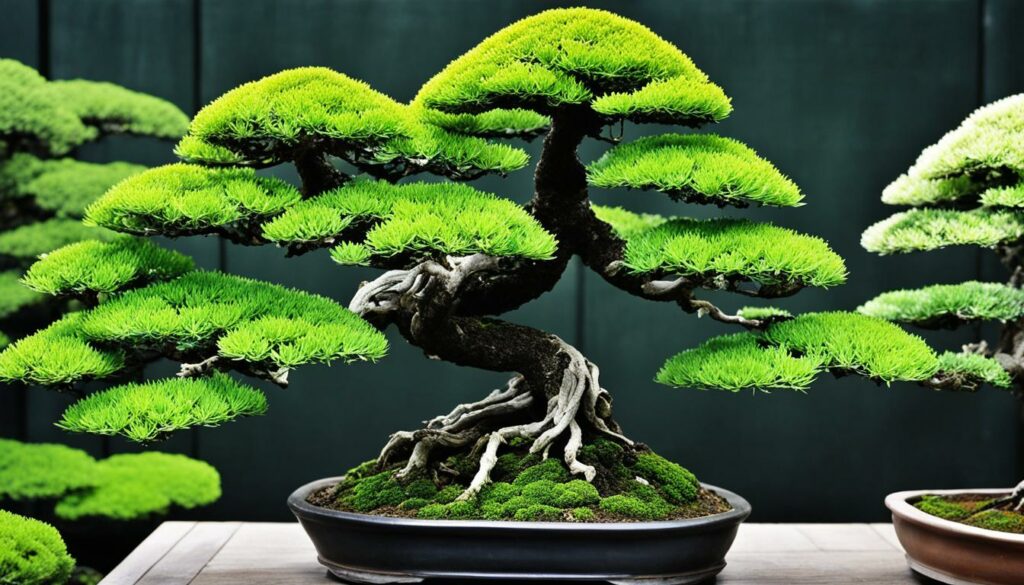
Understanding Bonsai Development Stages
Bonsai cultivation is an art that requires patience and dedication. Each bonsai tree goes through distinct stages of development on its journey to maturity. Understanding these stages and the bonsai timeline is crucial for proper care. Here’s an overview of the key development stages:
| Development Stage | Description |
|---|---|
| Initial Planting | When the bonsai seed or sapling is first planted in soil |
| Establishment | The roots develop and the trunk thickens |
| Branching | The bonsai starts to produce branches and foliage |
| Training | When the bonsai is shaped according to the desired style |
| Maintenance | Ongoing care to maintain the bonsai’s health and shape |
| Maturity | The bonsai reaches its final form and shape |
Each stage has specific milestones that mark the bonsai’s progression. For example, in the establishment stage, the bonsai’s roots should have spread out and rooted themselves into the soil. In the branching stage, the bonsai will produce its first set of branches. Monitoring these milestones is essential in tracking the bonsai’s development and progression.
Continue reading to learn about establishing the foundation of bonsai growth with proper soil and pot selection.
Establishing the Foundation: Soil and Pot Selection
When it comes to raising a healthy and thriving bonsai, selecting the right soil and pot is essential. Soil selection and pot size can impact the growth and development of the tree throughout its life cycle.
Soil selection can vary based on the needs of the bonsai species, but in general, it should provide ample drainage and aeration for root health. Choose from organic, inorganic, or a combination of both to build a nutrient-rich foundation for your bonsai.
Similarly, pot selection is equally important for optimal growth. Small, shallow pots are ideal for young trees, while deeper containers help to foster sturdy, well-rooted bonsai trees. Bear in mind, incorrect pot selection can stunt the tree’s growth and deform its trunk or roots.
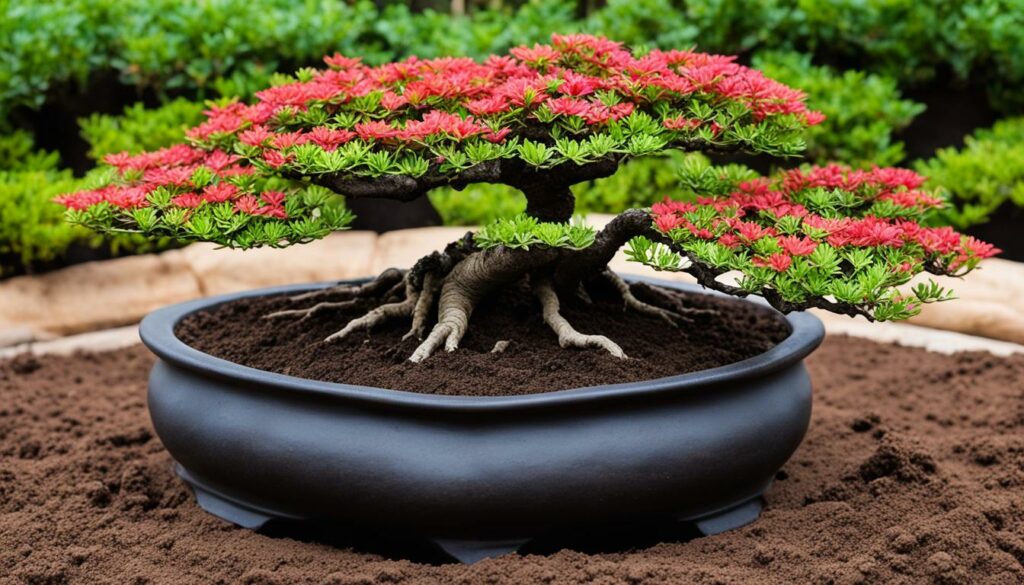
A guide to Soil and Pot Selection for your Bonsai
| Type of Soil | Description | Ideal For |
|---|---|---|
| Organic | Composed of natural materials such as peat moss and bark | Bonsai species that prefer more acidic soil, like the Pine and Azalea |
| Inorganic | Consists of clay and gravel particles | Bonsai species preferred by arid desert and alpine forests, like the Juniper and Cedar |
| Combination | A mixture of organic and inorganic soil components | Most bonsai species, including Chinese Elm, Ficus, and Maple |
Selecting the right soil and pot will ensure your bonsai has a solid foundation for growth and development. Careful consideration of these critical components will lay a reliable groundwork for your bonsai’s overall health and well-being.
Pruning and Shaping Techniques
Pruning and shaping techniques are crucial aspects of bonsai cultivation. The process of pruning involves removing unwanted growth, while shaping entails manipulating the tree’s branches, trunk, and foliage to achieve the desired aesthetic form.
Pruning should be executed throughout the year to maintain the desired shape and promote healthy growth. It is essential to keep the tools sanitized to minimize the risk of disease spreading.
Shaping techniques involve wiring, clipping, and carving. Wiring is a process of wrapping a thin wire around the branches to guide them in a specific direction. Clipping involves removing excess foliage using sharp scissors, and carving entails the removal of the bark and wood from a branch or trunk to create shapes.
It is important to understand the tree’s growth pattern before beginning shaping techniques to avoid severe damage to the tree. It is also essential to know when to stop shaping because excessive manipulation can cause stress to the tree, leading to its deterioration.
Tip: Proper pruning and shaping result in a healthy and thriving bonsai tree.
Wiring for Bonsai Development
Wiring is a common bonsai technique used to adjust the direction of branches and the trunk’s growth. It involves wrapping copper or aluminum wire along the branch or trunk and bending it gently to the desired shape. When done correctly, wiring is an effective method to enhance the aesthetic appeal of the tree and promote balanced growth.
Wiring should be done during the bonsai’s dormancy period and removed once the branch or trunk has set in the new shape, usually after a few months. Leaving the wire on for too long can cause the tree’s bark to grow around it, leading to damage or permanent scarring.
The thickness of the wire used should correspond to the branch’s size and flexibility, with thicker wire used for more rigid branches. Careful handling is crucial when wiring, as the branches and trunk are delicate and can be easily damaged. A good rule of thumb is to use the thinnest wire possible for the desired result.
When approaching wiring, consider the tree’s future growth patterns and direction. Wiring can manipulate the tree’s growth, but it cannot change its natural tendencies. Wiring is just a tool; the ultimate goal is to enhance the tree’s beauty while preserving its natural form.
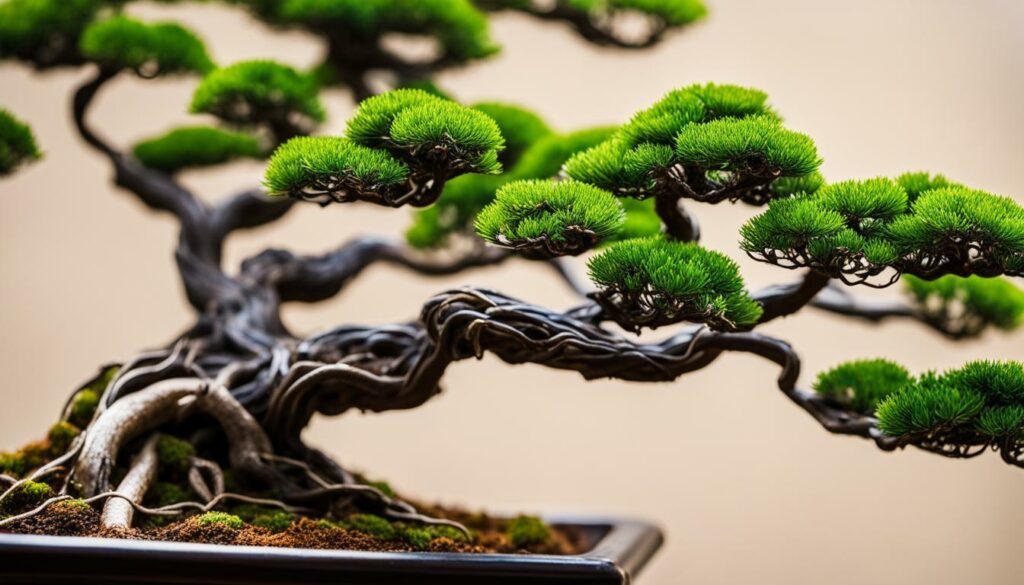
| Bonsai Type | Wire Thickness | Wiring Season |
|---|---|---|
| Deciduous | 1 to 3mm | Spring or Fall |
| Coniferous | 1 to 2mm | Early Spring or Late Fall |
| Tropical | 0.5 to 1.5mm | Year-round |
Remember that wiring should be a complementary technique, not the sole method used for bonsai development. Pairing it with pruning and shaping can lead to better results, as these methods allow for more accurate control over the tree’s growth patterns.
Training Bonsai through Repotting
Repotting is a crucial element of bonsai training. It involves removing the tree from its pot, trimming its roots, and placing it in fresh soil. Repotting should be carried out every two to three years, depending on the species, to ensure optimal growth and development.
When repotting, the ideal time is during the growth season, usually in the spring. This enables the tree to recover quickly from the root trimming and adjust to the new soil.
Repotting not only helps to refresh the soil and allows for better nutrient absorption but also reduces the likelihood of disease and insect infestations. To repot your bonsai, follow these simple steps:
| Steps for Repotting a Bonsai Tree |
|---|
| Step 1: Remove the tree from its current pot Step 2: Use bonsai scissors to trim away any diseased or damaged roots Step 3: Gently comb out the remaining roots to loosen them Step 4: Add fresh soil to the pot Step 5: Place the tree in the center of the pot Step 6: Fill the pot with soil and gently press it down Step 7: Water the newly repotted tree and allow the water to drain |
Upon successful repotting, avoid fertilizing the tree for several weeks. Fertilizing too early can lead to root burn or damage, stunting the tree’s growth. Allow it to rest for a few weeks before returning to its regular fertilizing schedule.
Repotting is a delicate process, but with patience and care, it can train your bonsai for optimal growth and development.
Watering and Fertilizing for Optimal Growth
Proper watering and fertilizing are crucial for optimal bonsai growth. It is essential to understand the appropriate amount of water and frequency to ensure your bonsai gets the nutrients it needs to thrive.
Watering:
When watering your bonsai, it’s important to provide consistent moisture without overwatering. The frequency of watering depends on the species, soil composition, and environment. It’s recommended to test the soil regularly to determine the watering requirements of your bonsai. As a rule of thumb, water your bonsai when the soil feels slightly dry or use a moisture meter to check the moisture level.
Fertilizing:
Bonsai trees require fertilizer for optimal growth. It’s crucial to choose the right type of fertilizer that provides the necessary nutrients for your bonsai’s growth. Nitrogen, phosphorus, and potassium are the primary macronutrients that bonsai trees need. The amount and frequency of fertilizing depend on the species, age, and season. It’s best to follow the manufacturer’s instructions for the type of fertilizer you use.
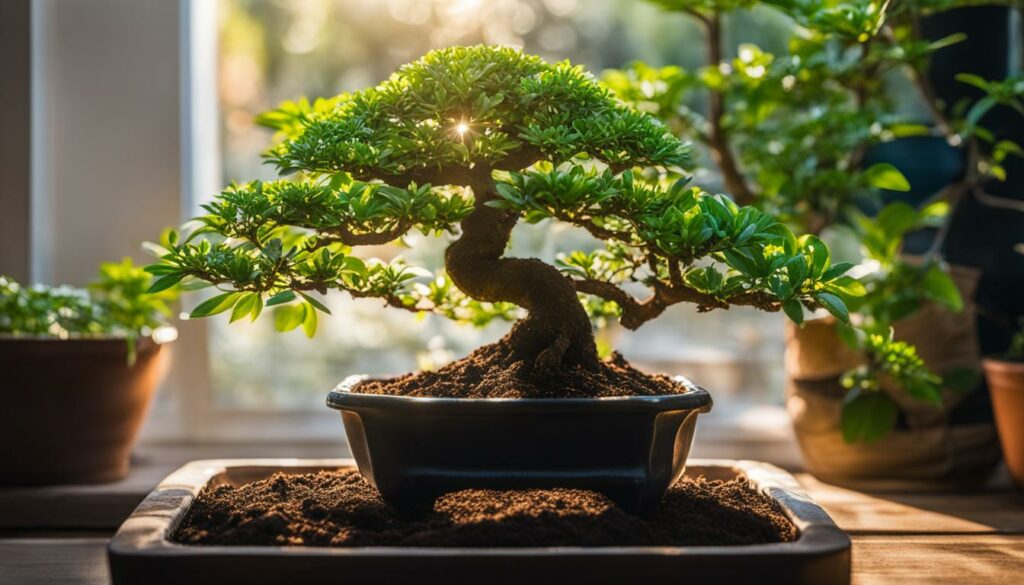
| Bonsai Species | Watering | Fertilizing |
|---|---|---|
| Juniper Bonsai | 1-2 times per week | Every 2-3 weeks during the growing season |
| Chinese Elm Bonsai | 1-2 times per week | Every 2-3 weeks during the growing season |
| Japanese Maple Bonsai | Every day during the growing season, every 2-3 days in winter | Every 2 weeks during the growing season |
Table: A guide to watering and fertilizing frequency for popular bonsai species.
Choosing the Right Fertilizer:
There are different types of fertilizer, including organic and inorganic. Organic fertilizer slowly releases nutrients and promotes root and soil health. Inorganic fertilizer provides an immediate nutrient boost and promotes leaf and branch growth. It’s crucial to choose the right type of fertilizer that suits your bonsai’s needs. When shopping for fertilizer, check the nutrient composition and ensure it meets the needs of your bonsai species.
Watering and fertilizing are essential factors in bonsai cultivation progression and development. By establishing a balanced watering schedule and choosing the right fertilizer, you can ensure your bonsai is healthy and vibrant.
Sunlight and Bonsai Development
Proper sunlight exposure is crucial for your bonsai’s growth and development. Just like any other plant, bonsai trees rely on sunlight to stimulate photosynthesis, which provides them with the energy they need to grow, thrive, and maintain their overall well-being.
However, it’s essential to understand that different bonsai species have varying lighting requirements. Some species thrive in direct sunlight, while others require indirect light or partial shade. As a bonsai grower, it’s your responsibility to understand and meet your bonsai’s specific lighting needs to promote optimal growth.
During the initial stages of your bonsai’s development, it’s critical to provide the tree with ample sunlight. This will encourage the growth of essential root and foliage systems that will sustain the tree throughout its maturity. As your bonsai tree becomes more established, it’s important to gradually adjust its lighting to match the species’ specific requirements. Doing so will promote healthy growth while also preventing issues such as leaf scorch or sunburn.
Tip: While it’s tempting to think that more sunlight equals better growth, it’s essential to strike the right balance. Too much direct sunlight can burn or dehydrate your bonsai tree, while too little sunlight can stunt its growth or cause it to become weak and susceptible to diseases.
To determine your bonsai’s lighting requirements, consider its species, the climate, and the time of year. Generally, the following lighting requirements apply to various stages of bonsai development:
| Bonsai Development Stage | Lighting Requirement |
|---|---|
| Newly Planted | Direct Sunlight |
| Root Development | Indirect Light |
| Foliage and Branching Development | Partial Shade |
| Flower and Fruit Development | Direct Sunlight |
Remember, proper sunlight exposure is only one part of bonsai tree care. Other factors such as soil, water, and fertilization are equally important in ensuring your bonsai’s overall health and development.
Protecting Bonsai in Extreme Weather Conditions
Bonsai trees are delicate and can be especially vulnerable in extreme weather conditions. Fortunately, there are steps you can take to protect your bonsai during harsh weather, including frost, heatwaves, and strong winds. By ensuring its continued development, you can keep your bonsai healthy and vibrant for years to come.
Frost Protection
Frost is a common problem in the colder months. It can damage your bonsai tree’s leaves and branches, causing long-term harm. To protect your bonsai from frost, you can:
- Cover the tree with a tarp or sheet to insulate from the cold
- Move the bonsai indoors during the coldest nights
- Water your bonsai the day before a frosty night to increase moisture retention
Keeping your bonsai protected from frost is critical during the winter months.
Heatwave Protection
Heatwaves are also a challenge for bonsai trees, as they can cause dehydration and sunburn. To protect your bonsai during a heatwave, you can:
- Move the tree into a shaded area during the hottest part of the day
- Water your bonsai more frequently during heatwaves to avoid dehydration
- Mist the leaves with water to cool them down and improve humidity
Protecting your bonsai from excessive heat will help ensure that it maintains its vibrancy and health.
Strong Wind Protection
Strong winds can be especially detrimental to bonsai trees, as they can cause broken branches and structural damage. To protect your bonsai from strong winds, you can:
- Move the tree indoors or to a sheltered area during the strongest winds
- Tie down the bonsai to prevent it from being knocked over or blown away
- Trim the tree regularly to reduce the surface area exposed to the wind
Protecting your bonsai from strong winds will help ensure its continued development and prevent structural damage.
Disease and Pest Management for Bonsai
Bonsai cultivation requires regular care and attention to keep your tree happy and healthy. However, even with proper care, your bonsai may still fall prey to pests and diseases. It is essential to be vigilant and take the necessary steps to prevent and treat potential issues to ensure your bonsai’s continued development and overall health.
Identifying Common Bonsai Pests and Diseases
Some common pests that may affect your bonsai include mites, aphids, and scales. These pests can cause significant damage to your tree, and symptoms may include discoloration, misshapen leaves, and stunted growth.
As for common bonsai diseases, root rot, leaf spot, and powdery mildew are just a few examples. Symptoms may include wilting, yellowing, or browning of the leaves, as well as general weakness or stunted growth.
Whether a pest or disease is affecting your bonsai, it is essential to identify the issue promptly to take the necessary steps to prevent further damage.
Preventive Measures for Disease and Pest Management
Preventive measures are vital in combating pests and diseases in bonsai cultivation. Simple techniques like crop rotation, proper pruning, and watering practices go a long way in keeping your bonsai healthy and free from pests and diseases.
It is also crucial to regularly inspect your bonsai tree, checking for any signs of pests or diseases, and carrying out the necessary preventive measures, including the use of organic pest control agents and fungicides.
Treating Bonsai Pests and Diseases
When preventive measures fail, it is essential to treat any pests or diseases affecting your bonsai promptly. Depending on the severity of the issue, treatments may range from using insecticides, fungicides, or antibiotics to manually removing infected parts of the tree.
However, it is crucial to note that some treatments can have harmful effects on your bonsai’s overall health. Always consult with a bonsai expert or specialist to determine the best course of action to treat your bonsai tree effectively.
Disease and Pest Management Table
| Pests | Symptoms | Prevention | Treatment |
|---|---|---|---|
| Mites | Discoloration, webbing, stunted growth | Regular inspection, use of predatory insects | Insecticidal sprays, manual removal |
| Aphids | Curling or distorted leaves, stunted growth | Regular inspection, use of sticky traps | Insecticidal sprays, manual removal |
| Scales | Yellowing leaves, black sooty mold on leaves | Regular inspection, use of horticultural oils | Insecticidal sprays, manual removal |
| Diseases | Symptoms depend on disease type | Cleanliness, proper watering, drainage | Fungicidal sprays, manual removal |
By being proactive in preventing and treating diseases and pests, you can keep your bonsai healthy and thriving. Remember to regularly inspect your tree, establish good cultivation practices, and seek the help of experts when needed.
Bonsai Progression Monitoring and Adjustment
Proper monitoring of your bonsai’s development progress is crucial for optimal growth and development. By keeping a close eye on the key indicators, you can make the necessary adjustments to ensure your bonsai remains healthy.
Indicators to Monitor
There are several indicators to monitor when assessing your bonsai’s development progress. These include:
- Leaf color: The color of the leaves can provide insight into your bonsai’s health. Yellow or brown leaves may indicate a nutrient deficiency or disease.
- Growth rate: Measuring growth rate can help you determine whether your bonsai is developing appropriately. Slow growth may indicate a lack of sunlight or moisture.
- Overall health: Regularly assess your bonsai’s overall health, including the trunk and branches, for any signs of disease or pest infestations.
Adjustment Techniques
Once you have identified areas in need of improvement, there are several techniques you can employ to adjust your bonsai’s development. These include:
- Pruning: Pruning can help shape your bonsai and encourage new growth. Cutting back overgrown branches can redirect energy to promote more balanced growth.
- Repotting: Repotting can help refresh the soil and eliminate any potential pest problems. It also gives you the opportunity to change the pot and soil to better suit your bonsai’s needs.
- Watering and fertilizing: Adjusting your watering schedule and fertilization routine can provide your bonsai with the necessary nutrients and moisture for healthy development.
Bonsai Care Tip:
Regularly monitoring your bonsai’s development progress and making necessary adjustments can be the difference between a healthy, thriving tree and a struggling one.
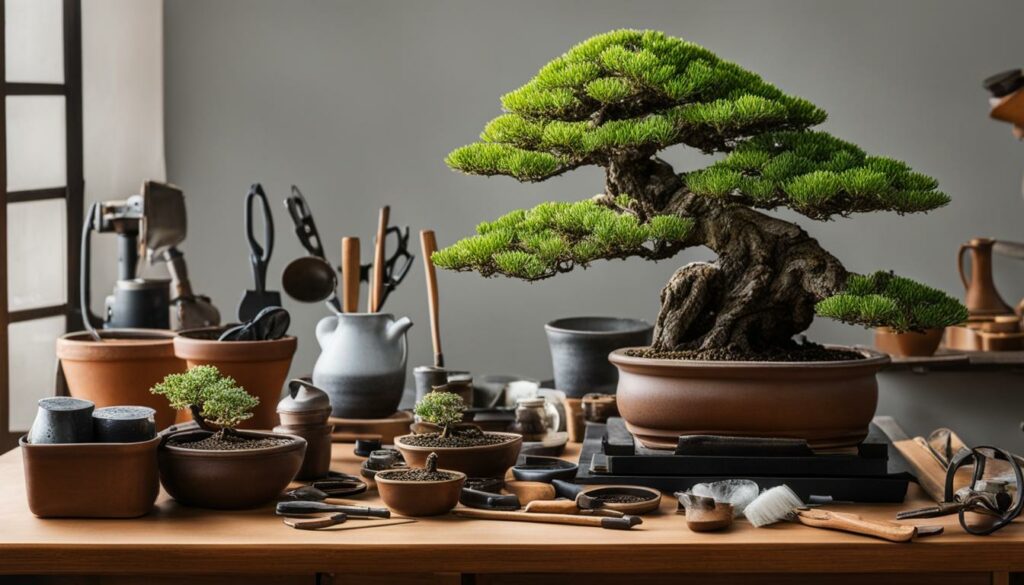
Bonsai Display and Aesthetic Development
The visual beauty of a bonsai can be enhanced by proper display techniques and aesthetic development. Choosing the right stand or container can have a significant impact on the aesthetic appeal of your bonsai tree.
Consider the size and shape of your bonsai when choosing a stand or container. It should complement the tree’s unique charm and not overpower it. Placement of the stand or container can also influence the overall effect of the display.
To achieve an aesthetically pleasing appearance, pay attention to the height and spread of the branches, the direction of growth, and the crown’s balance. Consider using accents such as rocks, moss, or figurines to enhance the display further.
Remember, aesthetic development is a continuous process as your bonsai develops. Monitor its growth and adjust the display technique accordingly to showcase its beauty effectively.
Choose a display technique that highlights the beauty of your bonsai and makes it stand out as a work of art.
Long-Term Bonsai Development and Legacy
As a bonsai enthusiast, it’s important to view bonsai cultivation as a long-term process. Patience and dedication are necessary to ensure the growth and development of your bonsai tree over time.
Planning for the future of your bonsai is also important. Consider developing a succession plan to pass on the legacy of your bonsai to future generations. This could involve identifying a future caretaker, sharing your knowledge and techniques with others, or even donating your bonsai to a museum or botanical garden.
Remember that the legacy of your bonsai tree extends beyond its aesthetic beauty. Your bonsai represents a living connection to the natural world and holds a unique history and story. By investing in the long-term development of your bonsai tree, you can preserve its legacy and ensure its continued growth for years to come.
| Action Item | Description |
|---|---|
| Identify Caretaker | Choose someone who is knowledgeable and passionate about bonsai cultivation to carry on the legacy of your bonsai tree. |
| Share Techniques | Pass on your bonsai cultivation techniques and knowledge to your caretaker or other interested individuals. |
| Document History | Record the history and story of your bonsai tree to preserve its legacy for future generations. |
| Consider Donation | Explore options for donating your bonsai tree to a museum or botanical garden to ensure its continued care and visibility. |
Conclusion
By now, you should have a better understanding of bonsai cultivation progression and development. Whether you’re a seasoned bonsai enthusiast or a beginner, it’s essential to follow the techniques and stages discussed in this article to ensure your bonsai tree thrives and evolves to its full potential.
Remember that choosing the right species, soil, pot, and lighting conditions are crucial for optimal growth. Pruning, shaping, wiring, and repotting are all techniques that will help you achieve the desired aesthetic form while encouraging growth in specific directions.
Monitoring your bonsai’s progress is vital, as is protecting it from extreme weather conditions and pests. Fertilizing and watering your bonsai tree regularly is also key to its long-term health and growth.
Finally, remember that bonsai cultivation is a long-term commitment. Planning for the future and passing on the bonsai legacy to future generations is a vital aspect of this art form.
We hope you found this article informative and helpful in your bonsai cultivation journey. Happy nurturing!
FAQ
What are the stages of bonsai tree development?
Bonsai trees go through various stages of development, starting from the initial planting and progressing to the training and shaping phases. The key stages include establishment, refinement, and maturity.
How long does it take for a bonsai tree to mature?
The time it takes for a bonsai tree to mature depends on various factors such as the species, care, and training techniques. On average, it can take several years to decades for a bonsai tree to reach its full maturity and aesthetic potential.
What is the significance of bonsai growth?
Bonsai growth is a transformative journey that allows the tree to develop its unique characteristics, trunk structure, and overall aesthetic beauty. It requires time, patience, and proper care to guide the bonsai tree towards its desired form.
How do I choose the right bonsai species for cultivation?
Selecting the right bonsai species depends on several factors such as the climate in your area, your level of expertise, and the desired style of your bonsai. It is crucial to research and understand the specific requirements and growth patterns of different bonsai species before making a selection.
What are the key milestones in bonsai tree development?
Bonsai tree development involves several notable milestones, including initial planting, training and shaping, branch development, ramification (branch division), leaf reduction, and mature form refinement. Each milestone represents a significant step in the bonsai’s progression and adds to its overall aesthetic appeal.
Why is soil and pot selection important for bonsai development?
Soil and pot selection are essential aspects of bonsai development. The right soil composition provides the necessary nutrients and drainage for healthy root growth, while an appropriately sized pot allows for proper root development and prevents root binding.
How can I prune and shape my bonsai tree effectively?
Pruning and shaping techniques involve removing specific branches and foliage to create the desired aesthetic form. It is crucial to understand the principles of bonsai styling and use appropriate tools to achieve balanced growth and promote the overall health of the tree.
What is the purpose of wiring in bonsai development?
Wiring is a technique used to shape the branches and trunk of a bonsai tree. It allows the bonsai enthusiast to guide the growth in specific directions, creating artistic shapes and forms. Wiring should be done carefully to avoid damaging the bark or restricting the tree’s natural growth.
How often should I repot my bonsai tree for optimal development?
Repotting frequency depends on the species and age of the bonsai tree. Generally, repotting is done every 1-3 years to prevent root congestion and improve the soil’s nutrient availability. It is important to follow proper repotting techniques and timing to minimize stress on the tree.
What is the importance of watering and fertilizing for bonsai growth?
Proper watering and fertilizing are crucial for bonsai growth and development. Watering should be done consistently, considering the tree’s specific water requirements and the climate. Fertilizing provides essential nutrients for healthy foliage and root development, but it should be done in moderation to avoid nutrient imbalances.
How does sunlight affect bonsai development?
Sunlight is vital for photosynthesis and overall bonsai health. Different bonsai species have varying sunlight requirements, ranging from full sun to partial shade. Providing adequate sunlight during the appropriate stages of development is essential for strong growth, coloration, and overall well-being of the bonsai tree.
How can I protect my bonsai tree in extreme weather conditions?
Extreme weather conditions such as frost, heatwaves, and strong winds can stress or damage bonsai trees. Protective measures like using frost covers, providing shade during intense heat, and securing the tree during strong winds can help safeguard the bonsai’s health and development.
How do I manage diseases and pests in my bonsai tree?
Regular inspection and proper care are crucial in preventing and managing diseases and pests in bonsai trees. Identifying common issues and taking appropriate measures such as using organic pesticides or implementing cultural practices can help maintain the tree’s health and promote successful development.
How do I monitor the progression of my bonsai tree’s development?
Monitoring the progression of your bonsai tree involves observing factors such as leaf color, growth rate, and overall health. Regular assessment allows you to identify any issues or areas that require adjustment, enabling you to optimize the tree’s growth and development.
How can I enhance the aesthetic development of my bonsai display?
Display techniques such as choosing the right bonsai stand or container, incorporating appropriate accent plants, and creating harmonious landscapes can enhance the overall aesthetic appeal of your bonsai display. It is important to consider the principles of design and balance to create a visually pleasing arrangement.
What are the long-term development strategies for bonsai cultivation?
Long-term development strategies for bonsai cultivation include succession planning, which involves training a successor to care for and continue the bonsai’s legacy. Additionally, passing on knowledge, techniques, and appreciation for bonsai to future generations ensures the continuous development and preservation of this art form.
